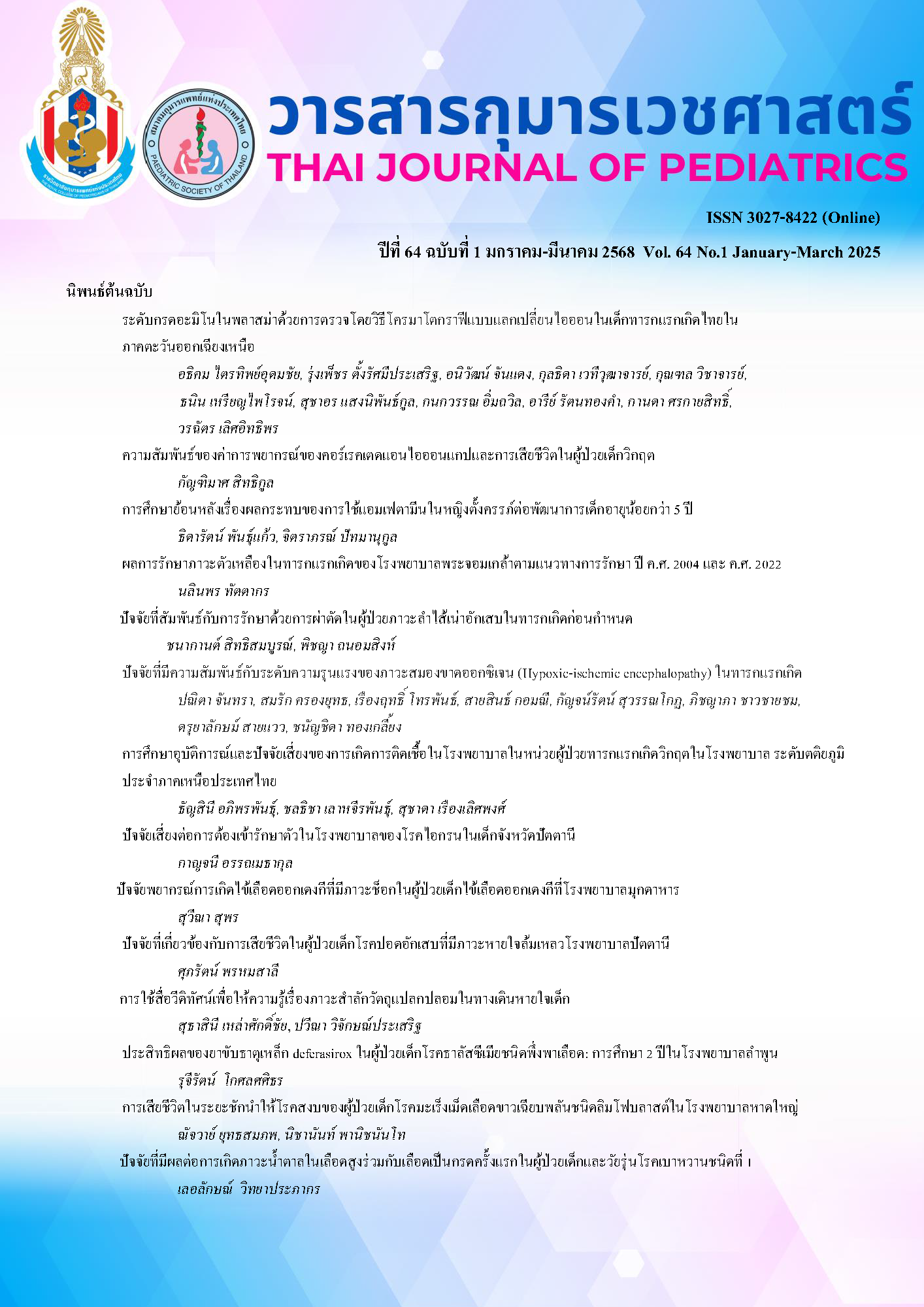การศึกษาย้อนหลังเรื่องผลกระทบของการใช้แอมเฟตามีนในหญิงตั้งครรภ์ต่อพัฒนาการเด็กอายุน้อยกว่า 5 ปี
คำสำคัญ:
แอมเฟตามีน, DSPM พัฒนาการ, การตั้งครรภ์, แอมเฟตามีน; DSPM; พัฒนาการ; ตั้งครรภ์; เสพแอมเฟตามีนก่อนคลอดบทคัดย่อ
ความเป็นมา: แอมเฟตามีนในครอบครัวส่งผลกระทบต่อเด็กหลายด้าน โดยเฉพาะอย่างยิ่งเมื่อได้รับตั้งแต่อยู่ในครรภ์ อย่างไรก็ตาม ข้อมูลเกี่ยวกับผลระยะยาวยังมีข้อจำกัดและจำเป็นต้องศึกษาเพิ่มเติม
วัตถุประสงค์: ศึกษาพัฒนาการของเด็กที่เกิดจากมารดาที่มีและไม่มีประวัติใช้แอมเฟตามีน เพื่อให้เข้าใจผลกระทบและแนวทางดูแลที่เหมาะสม
วิธีการ: เป็นการศึกษาย้อนหลังที่ใช้ข้อมูลจากเวชระเบียนของโรงพยาบาลอุตรดิตถ์ โดยวิเคราะห์ข้อมูลเด็กที่มีทะเบียนบ้านในจังหวัดอุตรดิตถ์ระหว่างวันที่ 1 ตุลาคม 2560 ถึง 30 กันยายน 2565 การรวบรวมข้อมูลใช้ผลจากคู่มือการเฝ้าระวังและส่งเสริมพัฒนาการ (the Developmental Surveillance and Promotion Manual, DSPM) ของศูนย์ข้อมูลสุขภาพอุตรดิตถ์ (Health Data Center, HDC) และเปรียบเทียบทางสถิติโดยใช้ risk regression ภายใต้ Poisson distribution เพื่อนำเสนอ effect size ด้วย risk ratio ในพัฒนาการ 5 ด้าน
ผลลัพธ์: กลุ่มตัวอย่างประกอบด้วยเด็ก 8,453 คนที่ได้รับการดูแลแรกเกิดที่โรงพยาบาลอุตรดิตถ์ และ 6,860 คนมีบันทึก DSPM ใน HDC อุตรดิตถ์ โดยแบ่งเป็นสองกลุ่มตามประวัติการเสพแอมเฟตามีนของมารดา ได้แก่ 6,798 คนที่มารดาไม่มีประวัติเสพ และ 62 คนที่มารดามีประวัติเสพแอมเฟตามีน (48 คนมีตรวจพบแอมเฟตามีนในปัสสาวะ และ 14 คนตรวจไม่พบ) เด็กที่มารดามีประวัติการเสพมีน้ำหนักแรกเกิดต่ำกว่าและแสดงพัฒนาการล่าช้าอย่างมีนัยสำคัญเมื่ออายุ 9 เดือน รวมถึงเด็กที่ไม่พบแอมเฟตามีนในปัสสาวะเมื่อแรกเกิดก็ยังแสดงพัฒนาการล่าช้าอย่างมีนัยสำคัญในทุกด้าน (3.31-7.33 เท่า) เทียบกับกลุ่มที่มารดาไม่มีประวัติการเสพ ในขณะที่เด็กที่มีผลตรวจแอมเฟตามีนเป็นบวกแสดงความล่าช้าอย่างมีนัยสำคัญในด้านกล้ามเนื้อมัดเล็ก การสื่อภาษา และสังคม-การช่วยเหลือตนเอง
สรุป: จากการศึกษาแสดงให้เห็นว่าเด็กที่เกิดจากมารดาที่มีประวัติการใช้แอมเฟตามีนมีพัฒนาการล่าช้าอย่างมีนัยสำคัญที่อายุ 9 เดือน แม้ว่าผลการตรวจปัสสาวะแอมเฟตามีนแรกเกิดจะเป็นลบ
Downloads
เอกสารอ้างอิง
Jarlenski MP, Paul NC, Krans EE. Polysubstance use among pregnant women with opioid use disorder in the United States, 2007–2016. Obstet Gynecol. 2020;136:556–64.
Admon LK, Bart G, Kozhimannil KB, Richardson CR, Dalton VK, Winkelman TNA. Amphetamine- and opioid-affected births: Incidence, outcomes, and costs, United States, 2004–2015. Am J Public Health. 2019;109:148–54.
Garey JD, Lusskin SI, Scialli AR. Teratogen update: Amphetamines. Birth Defects Res. 2020;112:1171–82.
Maranella E, Mareri A, Nardi V, Di Natale C, Di Luca L, Conte E, et al. Severe neurologic and hepatic toxicity in a newborn prenatally exposed to methamphetamine: A case report. Brain Dev. 2019;41:191–4.
Perez FA, Blythe S, Wouldes T, McNamara K, Black KI, Oei JL. Prenatal methamphetamine impact on the mother and child: A review. Addiction. 2022;117:250–60.
Notethasoung C. Neonatal outcomes and factors affecting the severity of amphetamine withdrawal symptoms in antenatal maternal amphetamine use. Chiangrai Med J. 2022;14:118–30.
Maranella E, Basti C, Di Fabio S. Methamphetamine abuse during pregnancy and its effect on fetal and neonatal outcome: A review. J Case Rep Clin Images. 2022;5:1104–9.
Sankaran D, Lakshminrusimha S, Manja V. Methamphetamine: Burden, mechanism, and impact on pregnancy, the fetus, and newborn. J Perinatol. 2022;42:293–9.
Chaiverapundech J, Kanchanabat S. Prenatal methamphetamine exposure and neonatal outcomes. Vajira Med J. 2017;60:53–64.
Schep LJ, Slaughter RJ, Beasley MG. The clinical toxicology of methamphetamine. Clin Toxicol (Phila). 2010;48:675–94.
Speranza RJ, Greiner KS, Rincon M, Beeraka SS, Burwick RM. Association between amphetamine use and pregnancy outcomes in women with a hypertensive disorder of pregnancy [24A]. Obstet Gynecol. 2019;133(Suppl 1):16.
Billing L, Eriksson M, Jonsson B, Steneroth G, Zetterström R. The influence of environmental factors on behavioral problems in 8-year-old children exposed to amphetamine during fetal life. Child Abuse Negl. 1994;18:3–9.
Cernerud L, Eriksson M, Jonsson B, Steneroth G, Zetterström R. Amphetamine addiction during pregnancy: 14-year follow-up of growth and school performance. Acta Paediatr. 1996;85:204–8.
Oei JL, Kingsbury A, Dhawan A, Burns L, Feller JM, Clews S, et al. Amphetamines, the pregnant woman, and her children: A review. J Perinatol. 2012;32:737–47.
Patcharoros N, Chulakadabba S, Manorom NN, Boon-Yasidhi V. Assessing child maltreatment in children born to mothers who used methamphetamine during pregnancy at Siriraj Hospital, Bangkok, Thailand: A pilot study. Int Sch Res Notices. 2014:406208.
Smith LM, LaGasse LL, Derauf C, Newman E, Shah R, et al. Motor and cognitive outcomes through three years of age in children exposed to prenatal methamphetamine. Neurotoxicol teratol. 2011;33:176-184.
Berman S, O'Neill J, Fears S, Bartzokis G, London ED. Abuse of amphetamines and structural abnormalities in the brain. Ann N Y Acad Sci. 2008;1141:195–220.
Aghazadeh R, Roshan-Milani S, Derafshpour L, Saboory E. Effects of prenatal methamphetamine exposure on spatial cognition and hippocampal synaptic plasticity in adolescent rats. Int J Dev Neurosci. 2022;82:471–85.
Verstegen RHJ, Wang G, Langenberg-Ververgaert KPS, Ren LY, Nulman I. Paternal exposure to recreational drugs before conception and its effect on live-born offspring: A scoping review. Birth Defects Res. 2020;112:970–88.
Khoshgoftar Some Saraii Z, Dianaty S, Rouhollah F, Zare N, Ghorbani Yekta B. Reproductive status of male rat offspring following exposure to methamphetamine during intrauterine life: An experimental study. Int J Reprod Biomed. 2023;21:175–84.
Rezazadeh M, Hajikhani R, Vaezi G, Bananej M. Evaluation of the effects of methamphetamine on amniotic sac composition in pregnant mice and their offspring. J Anim Biol. 2022;14:195–206.
Stek AM, Fisher BK, Baker RS, Lang U, Tseng CY, Clark KE. Maternal and fetal cardiovascular responses to methamphetamine in the pregnant sheep. Am J Obstet Gynecol. 1993;169:888–97.
Pankaew T, Jongatchariyakul P, Funoi M, Jiamsajjamongkol C, Budcha N. Bio-psycho-social health problems related to maternal amphetamine use in pediatric patients: A case report. J Phayao Hosp. 2023;2:29–36.
Rose SJ, Hathcock MA, White WM, Borowski K, Rivera-Chiauzzi EY. Amphetamine-dextroamphetamine and pregnancy: Neonatal outcomes after prenatal prescription mixed amphetamine exposure. J Atten Disord. 2021;25:1295–301.
Bang Madsen K, Robakis TK, Liu X, Momen N, Larsson H, Dreier JW, et al. In utero exposure to ADHD medication and long-term offspring outcomes. Mol Psychiatry. 2023;28:1739–46.
Chan B, Freeman M, Kondo K, Ayers C, Montgomery J, Paynter R, et al. Pharmacotherapy for methamphetamine/amphetamine use disorder: A systematic review and meta-analysis. Addiction. 2019;114:2122–36.
ดาวน์โหลด
เผยแพร่แล้ว
รูปแบบการอ้างอิง
ฉบับ
ประเภทบทความ
สัญญาอนุญาต
ลิขสิทธิ์ (c) 2025 ราชวิทยาลัยกุมารแพทย์แห่งประเทศไทย และ สมาคมกุมารแพทย์แห่งประเทศไทย

อนุญาตภายใต้เงื่อนไข Creative Commons Attribution-NonCommercial-NoDerivatives 4.0 International License.



